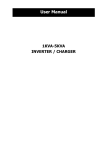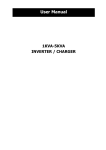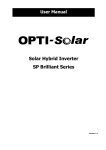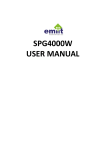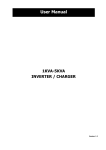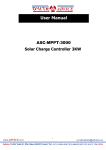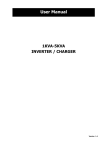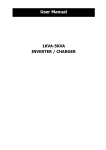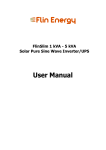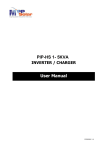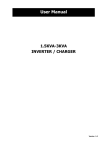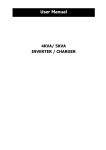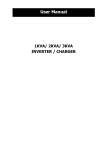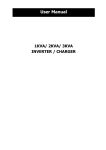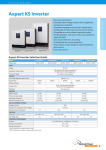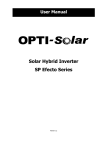Download USER`S MANUAL - Electrocomponents
Transcript
User Manual Solar Hybrid Inverter SP Brilliant Series Version: 1.2 Table Of Contents ABOUT THIS MANUAL ..................................................................................................................................... 1 Purpose ............................................................................................................................................................ 1 Scope ............................................................................................................................................................... 1 SAFETY INSTRUCTIONS.................................................................................................................................. 1 INTRODUCTION ............................................................................................................................................... 2 Features ........................................................................................................................................................... 2 Basic System Architecture ............................................................................................................................... 2 Product Overview............................................................................................................................................. 3 INSTALLATION ................................................................................................................................................. 4 Unpacking and Inspection................................................................................................................................ 4 Preparation....................................................................................................................................................... 4 Mounting the Unit ............................................................................................................................................. 4 Battery Connection .......................................................................................................................................... 5 AC Input/Output Connection ............................................................................................................................ 7 PV Connection ................................................................................................................................................. 8 Final Assembly ................................................................................................................................................. 9 Communication Connection ........................................................................................................................... 10 Dry Contact Signal ......................................................................................................................................... 10 OPERATION ..................................................................................................................................................... 11 Power ON/OFF .............................................................................................................................................. 11 Operation and Display Panel ......................................................................................................................... 11 LCD Display Icons ......................................................................................................................................... 12 LCD Setting .................................................................................................................................................... 14 Display Setting ............................................................................................................................................... 18 Operating Mode Description .......................................................................................................................... 22 Fault Reference Code .................................................................................................................................... 23 Warning Indicator ........................................................................................................................................... 24 SPECIFICATIONS ........................................................................................................................................... 25 Table 1 Line Mode Specifications ................................................................................................................... 25 Table 2 Inverter Mode Specifications ............................................................................................................. 26 Table 3 Charge Mode Specifications............................................................................................................... 27 Table 4 General Specifications ....................................................................................................................... 28 TROUBLE SHOOTING ..................................................................................................................................... 29 Appendix: Approximate Back-up Time Table ........................................................................................... 30 ABOUT THIS MANUAL Purpose This manual describes the assembly, installation, operation and troubleshooting of this unit. Please read this manual carefully before installations and operations. Keep this manual for future reference. Scope This manual provides safety and installation guidelines as well as information on tools and wiring. SAFETY INSTRUCTIONS WARNING: This chapter contains important safety and operating instructions. Read and keep this manual for future reference. 1. Before using the unit, read all instructions and cautionary markings on the unit, the batteries and all appropriate sections of this manual. 2. CAUTION --To reduce risk of injury, charge only deep-cycle lead acid type rechargeable batteries. Other types of batteries may burst, causing personal injury and damage. 3. Do not disassemble the unit. Take it to a qualified service center when service or repair is required. Incorrect re-assembly may result in a risk of electric shock or fire. 4. To reduce risk of electric shock, disconnect all wirings before attempting any maintenance or cleaning. Turning off the unit will not reduce this risk. 5. CAUTION – Only qualified personnel can install this device with battery. 6. NEVER charge a frozen battery. 7. For optimum operation of this inverter/charger, please follow required spec to select appropriate cable size. It’s very important to correctly operate this inverter/charger. 8. Be very cautious when working with metal tools on or around batteries. A potential risk exists to drop a tool to spark or short circuit batteries or other electrical parts and could cause an explosion. 9. Please strictly follow installation procedure when you want to disconnect AC or DC terminals. Please refer to INSTALLATION section of this manual for the details. 10. Fuses (4 pieces of 40A, 32VDC for 2KVA and 6 pieces for 3KVA, 1 piece of 200A, 58VDC for 5KVA) are provided as over-current protection for the battery supply. 11. GROUNDING INSTRUCTIONS -This inverter/charger should be connected to a permanent grounded wiring system. Be sure to comply with local requirements and regulation to install this inverter. 12. NEVER cause AC output and DC input short circuited. Do NOT connect to the mains when DC input short circuits. 13. Warning!! Only qualified service persons are able to service this device. If errors still persist after following troubleshooting table, please send this inverter/charger back to local dealer or service center for maintenance. 1 INTRODUCTION This is a multi-function inverter/charger, combining functions of inverter, MPPT solar charger and battery charger to offer uninterruptible power support with portable size. Its comprehensive LCD display offers user-configurable and easy-accessible button operation such as battery charging current, AC/solar charger priority, and acceptable input voltage based on different applications. Features Pure sine wave inverter Built-in MPPT solar charge controller Configurable input voltage range for home appliances and personal computers via LCD setting Configurable battery charging current based on applications via LCD setting Configurable AC/Solar Charger priority via LCD setting Compatible to mains voltage or generator power Auto restart while AC is recovering Overload/ Over temperature/ short circuit protection Smart battery charger design for optimized battery performance Cold start function Basic System Architecture The following illustration shows basic application for this inverter/charger. It also includes following devices to have a complete running system: Generator or Utility. PV modules (option) Consult with your system integrator for other possible system architectures depending on your requirements. This inverter can power all kinds of appliances in home or office environment, including motor-type appliances such as tube light, fan, refrigerator and air conditioner. Figure 1 Hybrid Power System 2 Product Overview 5KVA single model 2/3KVA model NOTE: For parallel model installation and operation, please check separate parallel installation guide for the details. 5KVA parallel model 1. LCD display 2. Status indicator 3. Charging indicator 4. Fault indicator 5. Function buttons 6. Power on/off switch 7. AC input 8. AC output 9. PV input 10. Battery input 11. Circuit breaker 12. RS232 communication port 13. Parallel communication cable (only for parallel model) 14. Current sharing cable (only for parallel model) 15. Dry contact 3 INSTALLATION Unpacking and Inspection Before installation, please inspect the unit. Be sure that nothing inside the package is damaged. You should have received the following items inside of package: The unit x 1 User manual x 1 Communication cable x 1 Software CD x 1 Preparation Before connecting all wirings, please take off bottom cover by removing two screws as shown below. Mounting the Unit Consider the following points before selecting where to install: Do not mount the inverter on flammable construction materials. Mount on a solid surface Install this inverter at eye level in order to allow the LCD display to be read at all times. The ambient temperature should be between 0°C and 55°C to ensure optimal operation. The recommended installation position is to be adhered to the wall vertically. Be sure to keep other objects and surfaces as shown in the right diagram to guarantee sufficient heat dissipation and to have enough space for removing wires. SUITABLE FOR MOUNTING ON CONCRETE OR OTHER NON-COMBUSTIBLE SURFACE ONLY. 4 Install the unit by screwing three screws. 2KVA/3KVA/5KVA Model Battery Connection CAUTION: For safety operation and regulation compliance, it’s requested to install a separate DC over-current protector or disconnect device between battery and inverter. It may not be requested to have a disconnect device in some applications, however, it’s still requested to have over-current protection installed. Please refer to typical amperage in below table as required fuse or breaker size. Ring terminal: WARNING! All wiring must be performed by a qualified personnel. WARNING! It's very important for system safety and efficient operation to use appropriate cable for battery connection. To reduce risk of injury, please use the proper recommended cable and terminal size as below. Recommended battery cable and terminal size: Model Typical Battery Amperage Capacity Wire Size Ring Terminal Cable 2 mm Torque Dimensions D (mm) L (mm) Value 2KVA 33A 100AH 1*10AWG 5 6.4 22.5 2~ 3 Nm 3KVA 50A 100AH 1*8AWG 8 6.4 23.8 2~ 3 Nm 5KVA 87A 1*4AWG 22 6.4 33.2 2*8AWG 14 6.4 29.2 200AH 2~ 3 Nm Please follow below steps to implement battery connection: 1. Assemble battery ring terminal based on recommended battery cable and terminal size. 2. Connect all battery packs as units requires. It’s suggested to connect at least 100Ah capacity battery for 1-3KVA model and at least 200Ah capacity battery for 4KVA/5KVA model. NOTE: Please only use sealed lead acid battery or sealed GEL/AGM lead-acid battery. 5 3. Insert the ring terminal of battery cable flatly into battery connector of inverter and make sure the bolts are tightened with torque of 2-3 Nm. Make sure polarity at both the battery and the inverter/charge is correctly connected and ring terminals are tightly screwed to the battery terminals. WARNING: Shock Hazard Installation must be performed with care due to high battery voltage in series. CAUTION!! Do not place anything between the flat part of the inverter terminal and the ring terminal. Otherwise, overheating may occur. CAUTION!! Do not apply anti-oxidant substance on the terminals before terminals are connected tightly. CAUTION!! Before making the final DC connection or closing DC breaker/disconnector, be sure positive (+) must be connected to positive (+) and negative (-) must be connected to negative (-). 6 AC Input/Output Connection CAUTION!! Before connecting to AC input power source, please install a separate AC breaker between inverter and AC input power source. This will ensure the inverter can be securely disconnected during maintenance and fully protected from over current of AC input. The recommended spec of AC breaker is 20A for 2KVA, 32A for 3KVA and 50A for 5KVA. CAUTION!! There are two terminal blocks with “IN” and “OUT” markings. Please do NOT mis-connect input and output connectors. WARNING! All wiring must be performed by a qualified personnel. WARNING! It's very important for system safety and efficient operation to use appropriate cable for AC input connection. To reduce risk of injury, please use the proper recommended cable size as below. Suggested cable requirement for AC wires Model 2KVA 3KVA 5KVA Gauge Torque Value 12 AWG 1.2~ 1.6 Nm 8 AWG 1.4~ 1.6Nm Please follow below steps to implement AC input/output connection: 1. Before making AC input/output connection, be sure to open DC protector or disconnector first. 2. Remove insulation sleeve 10mm for six conductors. And shorten phase L and neutral conductor N 3 mm. 3. Insert AC input wires according to polarities indicated on terminal block and tighten the terminal screws. Be sure to connect PE protective conductor ( ) first. →Ground (yellow-green) L→LINE (brown or black) N→Neutral (blue) WARNING: Be sure that AC power source is disconnected before attempting to hardwire it to the unit. 4. Then, insert AC output wires according to polarities indicated on terminal block and tighten terminal screws. Be sure to connect PE protective conductor ( ) first. →Ground (yellow-green) L→LINE (brown or black) N→Neutral (blue) 7 5. Make sure the wires are securely connected. CAUTION: Important Be sure to connect AC wires with correct polarity. If L and N wires are connected reversely, it may cause utility short-circuited when these inverters are worked in parallel operation. CAUTION: Appliances such as air conditioner are required at least 2~3 minutes to restart because it’s required to have enough time to balance refrigerant gas inside of circuits. If a power shortage occurs and recovers in a short time, it will cause damage to your connected appliances. To prevent this kind of damage, please check manufacturer of air conditioner if it’s equipped with time-delay function before installation. Otherwise, this inverter/charger will trig overload fault and cut off output to protect your appliance but sometimes it still causes internal damage to the air conditioner. PV Connection CAUTION: Before connecting to PV modules, please install separately a DC circuit breaker between inverter and PV modules. WARNING! All wiring must be performed by a qualified personnel. WARNING! It's very important for system safety and efficient operation to use appropriate cable for PV module connection. To reduce risk of injury, please use the proper recommended cable size as below. Model Typical Amperage Cable Size Torque 2KVA 3KVA 60A 8 AWG 5KVA 8 1.4~1.6 Nm PV Module Selection: When selecting proper PV modules, please be sure to consider below parameters: 1. Open circuit Voltage (Voc) of PV modules not exceeds max. PV array open circuit voltage of inverter. 2. Open circuit Voltage (Voc) of PV modules should be higher than min. battery voltage. Solar Charging Mode INVERTER MODEL 2KVA /3KVA / 5KVA Max. PV Array Open Circuit Voltage 145Vdc PV Array MPPT Voltage Range 60~115Vdc Min. battery voltage for PV charge 34Vdc Please follow below steps to implement PV module connection: 1. Remove insulation sleeve 10 mm for positive and negative conductors. 2. Check correct polarity of connection cable from PV modules and PV input connectors. Then, connect positive pole (+) of connection cable to positive pole (+) of PV input connector. Connect negative pole (-) of connection cable to negative pole (-) of PV input connector. 3. Make sure the wires are securely connected. Final Assembly After connecting all wirings, please put bottom cover back by screwing two screws as shown below. 2KVA /3KVA /5KVA 9 Communication Connection Please use supplied communication cable to connect to inverter and PC. Insert bundled CD into a computer and follow on-screen instruction to install the monitoring software. For the detailed software operation, please check user manual of software inside of CD. Dry Contact Signal There is one dry contact (3A/250VAC) available on the rear panel. It could be used to deliver signal to external device when battery voltage reaches warning level. Unit Status Power Off Condition NC & C NO & C Unit is off and no output is powered. Close Open Output is powered from Utility. Close Open Open Close Close Open Open Close Close Open Output is powered Program 01 Battery voltage < Low DC warning set as Utility voltage from Battery Power On Dry contact port: Battery voltage > Setting value in or Program 13 or battery charging Solar. reaches floating stage Program 01 is set SBU Solar first Battery voltage < Setting value in as Program 12 or Battery voltage > Setting value in Program 13 or battery charging reaches floating stage 10 OPERATION Power ON/OFF Once the unit has been properly installed and the batteries are connected well, simply press On/Off switch (located on the button of the case) to turn on the unit. Operation and Display Panel The operation and display panel, shown in below chart, is on the front panel of the inverter. It includes three indicators, four function keys and a LCD display, indicating the operating status and input/output power information. LCD display LED indicators Function keys LED Indicator LED Indicator Green Green Red Messages Solid On Output is powered by utility in Line mode. Flashing Output is powered by battery or PV in battery mode. Solid On Battery is fully charged. Flashing Battery is charging. Solid On Fault occurs in the inverter. Flashing Warning condition occurs in the inverter. Function Keys Function Key Description ESC To exit setting mode UP To go to previous selection DOWN To go to next selection ENTER To confirm the selection in setting mode or enter setting mode 11 LCD Display Icons Icon Function description Input Source Information Indicates the AC input. Indicates the PV input Indicate input voltage, input frequency, PV voltage, battery voltage and charger current. Configuration Program and Fault Information Indicates the setting programs. Indicates the warning and fault codes. Warning: Fault: flashing with warning code. lighting with fault code Output Information Indicate output voltage, output frequency, load percent, load in VA, load in Watt and discharging current. Battery Information Indicates battery level by 0-24%, 25-49%, 50-74% and 75-100% in battery mode and charging status in line mode. In AC mode, it will present battery charging status. Status Battery voltage <2V/cell Constant 2 ~ 2.083V/cell Current mode / Constant Voltage mode LCD Display 4 bars will flash in turns. Bottom bar will be on and the other three bars will flash in turns. Bottom two bars will be on and the other two bars will flash in turns. Bottom three bars will be on and the top 2.083 ~ 2.167V/cell > 2.167 V/cell bar will flash. Floating mode. Batteries are fully charged. 4 bars will be on. 12 In battery mode, it will present battery capacity. Load Percentage Battery Voltage LCD Display < 1.717V/cell 1.717V/cell ~ 1.8V/cell Load >50% 1.8 ~ 1.883V/cell > 1.883 V/cell < 1.817V/cell 1.817V/cell ~ 1.9V/cell 50%> Load > 20% 1.9 ~ 1.983V/cell > 1.983 < 1.867V/cell 1.867V/cell ~ 1.95V/cell Load < 20% 1.95 ~ 2.033V/cell > 2.033 Load Information Indicates overload. Indicates the load level by 0-24%, 25-50%, 50-74% and 75-100%. 0%~25% 25%~50% 50%~75% Mode Operation Information Indicates unit connects to the mains. Indicates unit connects to the PV panel. Indicates load is supplied by utility power. Indicates the utility charger circuit is working. Indicates the DC/AC inverter circuit is working. Mute Operation Indicates unit alarm is disabled. 13 75%~100% LCD Setting After pressing and holding ENTER button for 3 seconds, the unit will enter setting mode. Press “UP” or “DOWN” button to select setting programs. And then, press “ENTER” button to confirm the selection or ESC button to exit. Setting Programs: Program Description Selectable option Escape 00 Exit setting mode Solar energy provides power to the loads as first priority. If solar energy is not sufficient to power all connected loads, battery Solar first energy will supply power the loads at the same time. Utility provides power to the loads only when any one condition happens: - Solar energy is not available - Battery voltage drops to either low-level warning voltage or the setting point in program 12. Output source priority: 01 To configure load power Utility will provide power to the loads Utility first (default) source priority as first priority. Solar and battery energy will provide power to the loads only when utility power is not available. Solar energy provides power to the loads as first priority. If solar energy is not sufficient to SBU priority power all connected loads, battery energy will supply power to the loads at the same time. Utility provides power to the loads only when battery voltage drops to either low-level warning voltage or the setting point in program 12. 02 Maximum charging current: To configure total charging current for solar and utility chargers. (Max. charging current = utility charging current + solar charging current) Available options in 2KVA, 3KVA and 5KVA models: 10A 20A 30A 40A 14 50A 60A (default) Appliances (default) If selected, acceptable AC input voltage range will be within 95-140VAC(120V) or 03 AC input voltage range 90-280VAC(230V). UPS If selected, acceptable AC input voltage range will be within 65-140 VAC(120V) or 170-280VAC(230V). 04 Power saving mode enable/disable Saving mode disable If disabled, no matter connected load (default) is low or high, the on/off status of inverter output will not be effected. Saving mode enable If enabled, the output of inverter will be off when connected load is pretty low or not detected. 05 Battery type AGM (default) Flooded User-Defined If “User-Defined” is selected, battery charge voltage and low DC cut-off voltage can be set up in program 26, 27 and 29. Restart disable 06 Auto restart when overload occurs Restart enable (default) Restart disable Restart enable 07 Auto restart when over temperature occurs (default) 110V 120V 08 Output voltage (only available for 2KVA 120Vac models) 50Hz (default) 60Hz 09 Output frequency 15 Available options in 3KVA models: 10A 15A(default): Available options in 2KVA 120Vac model: 5A 11 Maximum utility charging current 10A(default) Available options in 5KVA models: 2A 10A 20A 30A (default) Battery Voltage 48VDC: 12 Setting voltage point back to utility source when selecting “SBU priority” or “Solar first” in program 01. 44V 45V 46V (default) 47V 48V 49V 50V 51V Battery Voltage 48V: 13 Setting voltage point back to battery mode when selecting “SBU priority” or “Solar first” in program 01. Battery fully charged 48V 49V 50V 51V 52V 16 53V 54V (default) 55V 56V 57V 58V If this inverter/charger is working in Line, Standby or Fault mode, charger source can be programmed as below: Solar first Solar energy will charge battery as first priority. Utility will charge battery only when solar energy is not available. Utility first Utility will charge battery as first priority. Solar energy will charge battery only when utility power is not available. Charger source priority: 16 To configure charger source Solar and Utility priority (Only available for 4KVA/5KVA model) Only Solar Solar energy and utility will charge battery at the same time. Solar energy will be the only charger source no matter utility is available or not. If this inverter/charger is working in Battery mode or Power saving mode, only solar energy can charge battery. Solar energy will charge battery if it's available and sufficient. 18 19 Alarm on (default) Alarm off Return to default If selected, no matter how users display screen switch display screen, it will (default) automatically return to default display Alarm control screen (Input voltage /output voltage) Auto return to default display screen after no button is pressed for 1 minute. Stay at latest screen If selected, the display screen will stay at latest screen user finally switches. 17 Backlight on 20 Backlight control 22 Beeps while primary source is interrupted 23 Overload bypass: When enabled, the unit will transfer to line mode if overload occurs in battery mode. (default) Alarm on (default) Alarm off Bypass disable Bypass enable (default) Record enable 25 Backlight off Record disable (default) Record Fault code 48V model default setting: 56.4V 26 Bulk charging voltage (C.V voltage) If self-defined is selected in program 5, this program can be set up. Setting range is from 48.0V to 58.4V for 48V model. Increment of each click is 0.1V. 48V model default setting: 54.0V 27 Floating charging voltage If self-defined is selected in program 5, this program can be set up. Setting range is from 48.0V to 58.4V for 48V model. Increment of each click is 0.1V. 48V model default setting: 42.0V If self-defined is selected in program 5, this program can be 29 Low DC cut-off voltage set up. Setting range is from 40.0V to 48.0V for 48V model. Increment of each click is 0.1V. Low DC cut-off voltage will be fixed to setting value no matter what percentage of load is connected. Then, low DC warning voltage is 2V higher than cut-off voltage, low DC warning return voltage is 4V higher than cut-off voltage and Cold Start Voltage is 4V higher than cut-off voltage. Display Setting The LCD display information will be switched in turns by pressing “UP” or “DOWN” key. The selectable information is switched as below order: input voltage, input frequency, PV voltage, MPPT charging current, MPPT charging power, battery voltage, output voltage, output frequency, load percentage, load in VA, load in Watt, DC discharging current, main CPU Version and second CPU Version. 18 Selectable information LCD display Input Voltage=230V, output voltage=230V Input voltage/Output voltage (Default Display Screen) Input frequency=50Hz Input frequency PV voltage=60V PV voltage Current ≧10A MPPT Charging current MPPT Charging power Current < 10A MPPT charging power=500W Battery voltage=25.5V, discharging current=1A Battery voltage/ DC discharging current 19 Output frequency=50Hz Output frequency Load percent=70% Load percentage When connected load is lower than 1kVA, load in VA will present xxxVA like below chart. Load in VA When load is larger than 1kVA (≧1KVA), load in VA will present x.xkVA like below chart. When load is lower than 1kW, load in W will present xxxW like below chart. Load in Watt When load is larger than 1kW (≧1KW), load in W will present x.xkW like below chart. 20 Main CPU version 00014.04 Main CPU version checking Secondary CPU version 00003.03 Secondary CPU version checking 21 Operating Mode Description Operation mode Description LCD display Charging by utility. Standby mode / Power saving mode Note: *Standby mode: The inverter is not turned on yet but at this No output is supplied by the time, the inverter can charge unit but it still can charge battery without AC output. batteries. Charging by PV energy. *Power saving mode: If enabled, the output of inverter No charging. will be off when connected load is pretty low or not detected. Charging by utility. (Only available in 2K/3K model) Fault mode Note: *Fault mode: Errors are caused by inside circuit error or external reasons such as over PV energy and utility can Charging by PV energy. charge batteries. temperature, output short circuited and so on. No charging. Fault mode Note: Utility can power loads when *Fault mode: Errors are caused the unit starts up without by inside circuit error or external battery. (Only available in reasons such as over 4K/5K model with single temperature, output short operation) Power from utility circuited and so on. Charging by PV energy The unit will provide output Line Mode power from the mains. It will also charge the battery at line mode. Charging by utility. 22 Power from battery and PV energy. The unit will provide output Battery Mode power from battery and PV power. Power from battery only. Fault Reference Code Fault Code Fault Event 01 Fan is locked when inverter is off. 02 Over temperature 03 Battery voltage is too high 04 Battery voltage is too low 05 06 Icon on Output short circuited or over temperature is detected by internal converter components. Output voltage is abnormal. (For 2K/3K model) Output voltage is too high. (For 5K model) 07 Overload time out 08 Bus voltage is too high 09 Bus soft start failed 11 Main relay failed 51 Over current or surge 52 Bus voltage is too low 53 Inverter soft start failed 55 Over DC voltage in AC output 56 Battery connection is open 57 Current sensor failed 58 Output voltage is too low NOTE: Fault codes 51, 52, 53, 55, 56, 57 and 58 are only available in 5K model. 23 Warning Indicator Warning Code Warning Event Audible Alarm 01 Fan is locked when inverter is on. Beep three times every second 03 Battery is over-charged Beep once every second 04 Low battery Beep once every second 07 Overload Beep once every 0.5 second 10 Output power derating Beep twice every 3 seconds 12 13 14 Solar charger stops due to low battery. Solar charger stops due to high PV voltage. Solar charger stops due to overload. 24 Icon flashing SPECIFICATIONS Table 1 Line Mode Specifications INVERTER MODEL 2KVA 3KVA Input Voltage Waveform Nominal Input Voltage 5KVA Sinusoidal (utility or generator) 120Vac 230Vac 95Vac±7V(UPS); 170Vac±7V (UPS); 65Vac±7V(Appliances) 90Vac±7V (Appliances) 100Vac±7V(UPS); 180Vac±7V (UPS); 70Vac±7V(Appliances) 100Vac±7V (Appliances) High Loss Voltage 140Vac±7V 280Vac±7V High Loss Return Voltage 135Vac±7V 270Vac±7V 150Vac 300Vac Low Loss Voltage Low Loss Return Voltage Max AC Input Voltage Nominal Input Frequency 50Hz / 60Hz (Auto detection) Low Loss Frequency 40±1Hz Low Loss Return 42±1Hz Frequency High Loss Frequency 65±1Hz High Loss Return 63±1Hz Frequency Output Short Circuit Line mode: Circuit Breaker Protection Battery mode: Electronic Circuits Efficiency (Line Mode) >95% ( Rated R load, battery full charged ) 10ms typical (UPS); Transfer Time 20ms typical (Appliances) Output Power Output power derating: Rated Power When AC input voltage drops to 170V, the output power will be derated. 50% Power 90V 25 170V 280V Input Voltage Table 2 Inverter Mode Specifications INVERTER MODEL Rated Output Power 2KVA 3KVA 5KVA 2KVA/1.6KW 3KVA/2.4KW 5KVA/4KW Pure Sine Wave Output Voltage Waveform Output Voltage Regulation 110/120VAC±5% 230Vac±5% 60Hz or 50Hz Output Frequency 90% Peak Efficiency Overload Protection 5s@≥150% load; 10s@110%~150% load 2* rated power for 5 seconds Surge Capacity Nominal DC Input Voltage 48Vdc Cold Start Voltage 46.0Vdc Low DC Warning Voltage @ load < 20% 44.0Vdc @ 20% ≤ load < 50% 42.8Vdc @ load ≥ 50% 40.4Vdc Low DC Warning Return Voltage @ load < 20% 46.0Vdc @ 20% ≤ load < 50% 44.8Vdc @ load ≥ 50% 42.4Vdc Low DC Cut-off Voltage @ load < 20% 42.0Vdc @ 20% ≤ load < 50% 40.8Vdc @ load ≥ 50% 38.4Vdc High DC Recovery Voltage 58Vdc High DC Cut-off Voltage 62Vdc No Load Power Consumption Saving Mode Power Consumption 26 <25W <50W <10W <15W Table 3 Charge Mode Specifications Utility Charging Mode INVERTER MODEL Charging Current (UPS) @VI/P=230Vac Bulk Charging Voltage 2KVA 3KVA 5KVA 5/10A 10/15A 20/30A Flooded 58.4Vdc Battery AGM / Gel 56.4Vdc Battery Floating Charging Voltage 54Vdc Charging Algorithm 3-Step Battery Voltage, per cell Charging Current, % 2.43Vdc (2.35Vdc) Voltage 2.25Vdc 100% Charging Curve 50% T0 T1 T1 = 10* T0, minimum 10mins, maximum 8hrs Current Bulk (Constant Current) Absorption (Constant Voltage) Maintenance (Floating) Solar Charging Mode INVERTER MODEL 2KVA/3KVA/5KVA Rated Power 3000W Efficiency 98.0% max. Max. PV Array Open Circuit Voltage 145Vdc PV Array MPPT Voltage Range 60~115Vdc Min battery voltage for PV charge 34Vdc Standby Power Consumption 2W Battery Voltage Accuracy +/-0.3% PV Voltage Accuracy +/-2V Charging Algorithm 3-Step 27 Time Table 4 General Specifications INVERTER MODEL 2KVA / 3KVA Operating Temperature 0°C to 55°C Range Storage temperature Dimension (D*W*H), mm 5KVA -15°C~ 60°C 140 x 295 x 479 140 x295 x540 11.5 13.5 Net Weight, kg 28 TROUBLE SHOOTING Problem Unit shuts down automatically during startup process. No response after power on. Mains exist but the unit works in battery mode. When the unit is turned on, internal relay is switched on and off repeatedly. LCD/LED/Buzzer Explanation / Possible cause LCD/LEDs and buzzer will be active for 3 seconds and then complete off. The battery voltage is too low (<1.91V/Cell) 1. Re-charge battery. 2. Replace battery. No indication. 1. The battery voltage is far too low. (<1.4V/Cell) 2. Battery polarity is connected reversed. 1. Check if batteries and the wiring are connected well. 2. Re-charge battery. 3. Replace battery. Input voltage is displayed as 0 on the LCD and green LED is flashing. Input protector is tripped Check if AC breaker is tripped and AC wiring is connected well. Green LED is flashing. Insufficient quality of AC power. (Shore or Generator) Green LED is flashing. Set “Solar First” as the priority of output source. LCD display and LEDs are flashing Battery is disconnected. Fault code 07 Overload error. The inverter is overload 110% and time is up. Output short circuited. Fault code 05 1. Check if AC wires are too thin and/or too long. 2. Check if generator (if applied) is working well or if input voltage range setting is correct. (UPSAppliance) Change output source priority to Utility first. Check if battery wires are connected well. Reduce the connected load by switching off some equipment. Check if wiring is connected well and remove abnormal load. Temperature of internal converter component is over 120°C. (Only available for 2/3KVA models.) Internal temperature of inverter component is over 100°C. Check whether the air flow of the unit is blocked or whether the ambient temperature is too high. Battery is over-charged. Return to repair center. The battery voltage is too high. Check if spec and quantity of batteries are meet requirements. Fault code 01 Fan fault Replace the fan. Fault code 06/58 Output abnormal (Inverter voltage below than 190Vac or is higher than 260Vac) 1. Reduce the connected load. 2. Return to repair center Fault code 08/09/53/57 Internal components failed. Return to repair center. Fault code 51 Over current or surge. Fault code 52 Bus voltage is too low. Fault code 55 Output voltage is unbalanced. Fault code 56 Battery is not connected well or fuse is burnt. Fault code 02 Buzzer beeps continuously and red LED is on. What to do Fault code 03 29 Restart the unit, if the error happens again, please return to repair center. If the battery is connected well, please return to repair center. Appendix: Approximate Back-up Time Table Model 2KVA 3KVA 5KVA Load (VA) Backup Time @ 48Vdc 100Ah (min) Backup Time @ 48Vdc 200Ah (min) 200 1581 3161 400 751 1581 600 491 1054 800 331 760 1000 268 615 1200 221 508 1400 172 387 1600 136 335 1800 120 295 2000 106 257 300 1054 2107 600 491 1054 900 291 668 1200 196 497 1500 159 402 1800 123 301 2100 105 253 2400 91 219 2700 71 174 3000 63 155 500 613 1288 1000 268 613 1500 158 402 2000 111 271 2500 90 215 3000 76 182 3500 65 141 4000 50 112 4500 44 100 5000 40 90 Note: Backup time depends on the quality of the battery, age of battery and type of battery. Specifications of batteries may vary depending on different manufacturers. 30
































